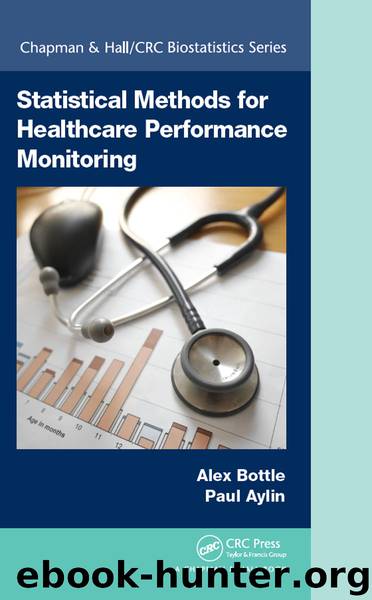Statistical Methods for Healthcare Performance Monitoring by Alex Bottle & Paul Aylin

Author:Alex Bottle & Paul Aylin
Language: eng
Format: epub
Publisher: CRC Press
7.5 Marginal versus Multilevel Models (*)
When there are two levels to the data, for example, when patients are clustered only within hospitals, a viable alternative to hierarchical modelling is the marginal model. This was briefly mentioned in Chapter 3 but is worth a bit more space here. Marginal models use generalised estimating equations (GEEs) rather than maximum likelihood to estimate their parameters. In addition to the usual assumption that the outcome variable follows the appropriate distribution such as the binomial for binary outcomes, it’s assumed that patients within a unit have correlated outcomes but patient outcomes in different units are independent, that is, have zero correlation. One nice feature of GEEs is that we don’t need to know the structure of the correlation between patient outcomes at the same unit. The GEE method includes the calculation of robust estimates for the standard errors of the regression coefficients that give the correct results even if the correlation structure you choose isn’t the right one or if the strength of the correlation between patient outcomes within the same unit varies somewhat from patient to patient. They tend to be more popular in epidemiology than in health services research.
The interpretation of effect estimates differs for marginal and multilevel models for binary outcomes. This is true not just for patient factors but also for hospital-level effects such as SMRs (Sanagou et al. 2012). The predicted probability of the outcome depends on both patient-level and hospital-level covariates. Let’s first think about patient factors and what their coefficients mean. In an ordinary logistic regression model, that is, one that ignores any clustering and is neither marginal nor multilevel, suppose that the odds ratio for being female is 1.2. This means that females have a 20% higher odds of death than males in the population as a whole. It doesn’t depend on what hospital they went to. The interpretation of fixed effect coefficients, for example, the effect of being female in this example, is the same in ordinary and marginal logistic regression and is straightforward. In a marginal model, odds ratios estimate the effect of predictors on the population as a whole, averaged over the set of delta_j, rather than their effect on a typical hospital (Hu et al. 1998). In a multilevel model, however, the probability of the outcome for a given patient depends not just on their casemix factors like age and sex but also on the random effect of the hospital that they attended (delta_j). Therefore, the usual odds ratio interpretations, such as females having a 20% higher odds of death than males, apply for comparisons of patients only within the same hospital (or those with the same value of the random effect delta_j).
Now let’s think about what coefficients for hospital-level factors mean. Odds ratios for hospital-level factors, for example, teaching status, in a marginal model represent the odds of the outcome for hospitals with one value of the factor compared with hospitals with another value of the factor. Again, this is straightforward. In
Download
This site does not store any files on its server. We only index and link to content provided by other sites. Please contact the content providers to delete copyright contents if any and email us, we'll remove relevant links or contents immediately.
| Administration & Medicine Economics | Allied Health Professions |
| Basic Sciences | Dentistry |
| History | Medical Informatics |
| Medicine | Nursing |
| Pharmacology | Psychology |
| Research | Veterinary Medicine |
Good by S. Walden(3488)
The Social Psychology of Inequality by Unknown(2940)
0041152001443424520 .pdf by Unknown(2784)
The Checklist Manifesto by Atul Gawande(2779)
The Meaning of the Library by unknow(2505)
Guns, Germs and Steel by Diamond Jared(2303)
Borders by unknow(2228)
23:27 by H. L. Roberts(2195)
And the Band Played On by Randy Shilts(2129)
Get What's Yours for Medicare: Maximize Your Coverage, Minimize Your Costs by Philip Moeller(2097)
Being Mortal: Medicine and What Matters in the End by Atul Gawande(2084)
A Leg to Stand On by Oliver Sacks(2005)
The Hot Zone by Richard Preston(1983)
The Valachi Papers by Peter Maas(1811)
The Laws of Medicine by Siddhartha Mukherjee(1755)
The Andromeda Strain by Michael Crichton(1696)
The Obesity Epidemic by Robyn Toomath(1646)
Pharmacy Practice and The Law by Richard Abood(1542)
Autism's False Prophets by Paul A. Offit(1496)
